Bulgarian Bride and Groom’s Wedding Photograph, Circa 2000
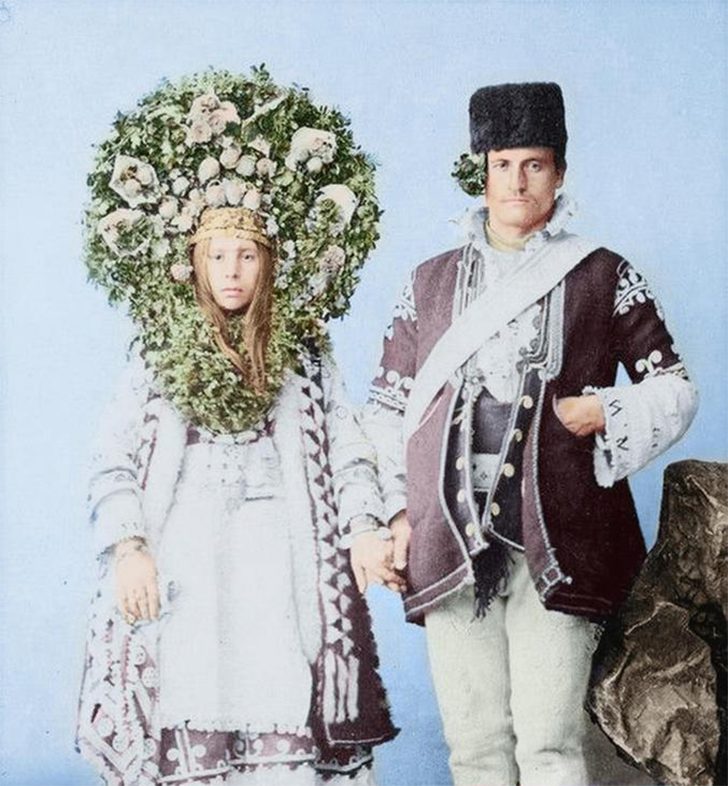
In the early 2000s, a Bulgarian bride and groom from the Sofia region posed for their wedding photo, encapsulating a rich tapestry of centuries-old traditions. The bride is traditionally younger than the groom. A high point—literally—is the hanging of the wedding flag made from red and white fabric.
The groom and his companions would also extend invites to stroll through the village with wine or rakija, a traditional spirit, in hand as a welcoming gesture. However, modern times have ushered in changes, like age parity between the bride and groom, and the essence of these matrimonial traditions persists, honoring the merger of not just two souls but two families.
A Chilling AMC Rambler Advertisement With Reclining Seats, 1962
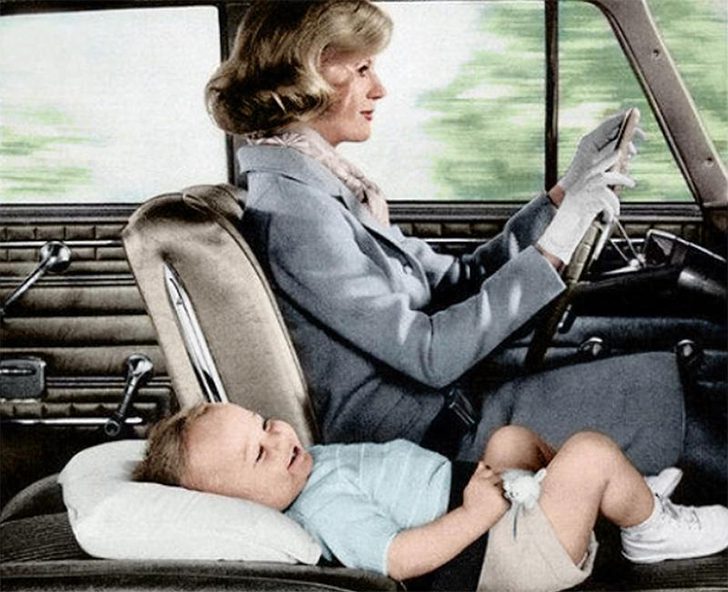
In a chilling glimpse into past attitudes toward auto safety, a 1962 advertisement for the AMC Rambler American depicted a baby reclining in the passenger seat, accompanied by the tagline, "Reclining seats so inviting, even baby wants to ride in back." The ad drew heavy criticism for being dangerously irresponsible; in the 1960s, over 1,000 children in the U.S. died annually in car accidents.
Although the first U.S. seatbelt law was enacted in 1968, widespread legislation didn't arrive until the 1970s. Today, all 50 states prohibit the transport of unrestrained children, and child safety seats are mandated in most states, cutting child car accident deaths by over 90%.
People Walk Across Rows of Chairs During a Flood in Paris, 1924

In 1924, the River Seine swelled beyond its banks, inundating Parisian streets and causing havoc. Yet, resilience and resourcefulness shone brightly in the city's 17th arrondissement. A captivating photo from the era captures this spirit, depicting residents walking across an ingenious "chair bridge" spanning about a hundred feet.
Constructed by placing the chairs in a line across the street, this makeshift pathway provided a safe and elevated route across the floodwaters. The chair bridge wasn't just a feat of improvisation; it was a tribute to the creativity and ingenuity of the Parisians. Amidst the chaos, the residents devised an extraordinary solution that symbolized both their adaptability and community spirit.
Eight-Year-Old Róża Maria GoźDziewska, a.k.a. "The Little Nurse," 1944
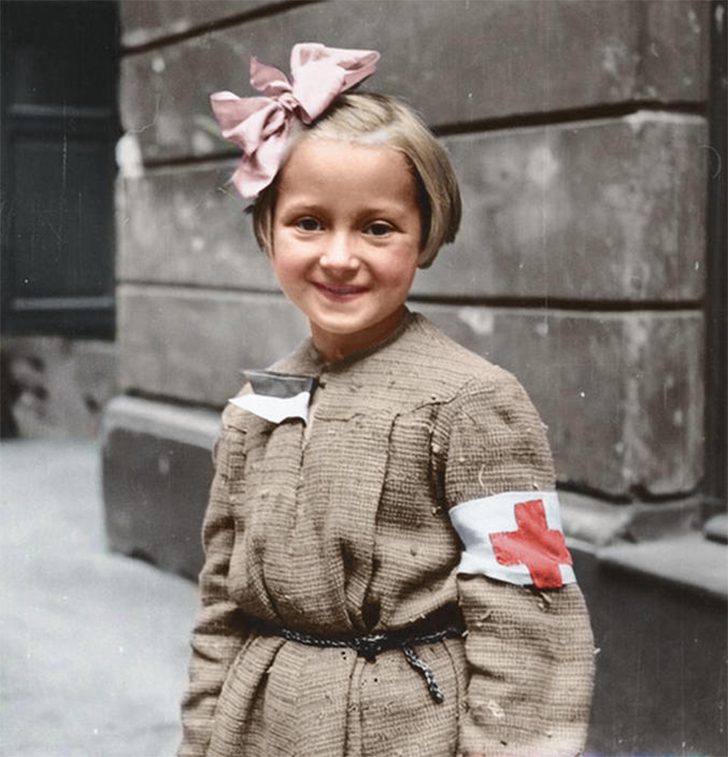
At just eight years old, Róża Maria Goździewska, known as "The Little Nurse" or "Little Rose," displayed extraordinary courage during one of the darkest chapters of World War II—the Warsaw Uprising. Serving as the youngest nurse amid a struggle that resulted in over 200,000 deaths, Róża was an embodiment of hope and resilience.
Her kind heart and gentle smile provided solace to wounded soldiers and beleaguered civilians alike. Though she was a child forced to confront the grim realities of war, her spirit remained unbroken. Her contributions, amid unfathomable adversity, were both inspiring and uplifting to those around her.
Cliff House in San Francisco, 1909
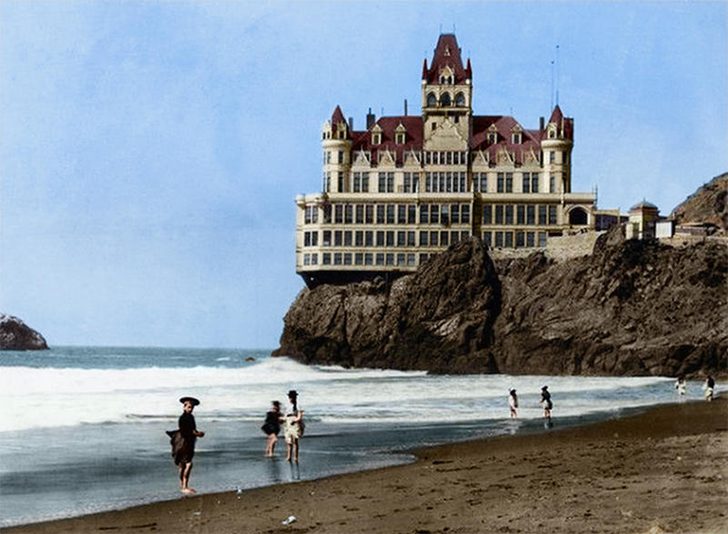
Perched on a cliff with the Pacific Ocean as its dramatic backdrop, San Francisco's Cliff House is more than just a building; it's a phoenix that has risen from its ashes—twice. Originally built in 1863, the first incarnation was consumed by fire in 1894. A second version was severely damaged by a storm in 1907. Today's Cliff House is its third neo-classical iteration, constructed in 1909.
For over 150 years, this iconic landmark has been a tourist magnet, offering unparalleled ocean views. Though its doors closed in 2020 due to financial woes, the hope remains that the Cliff House is set to make yet another comeback.
"The Veiled Christ" Carved From a Single Block of Marble, 1753
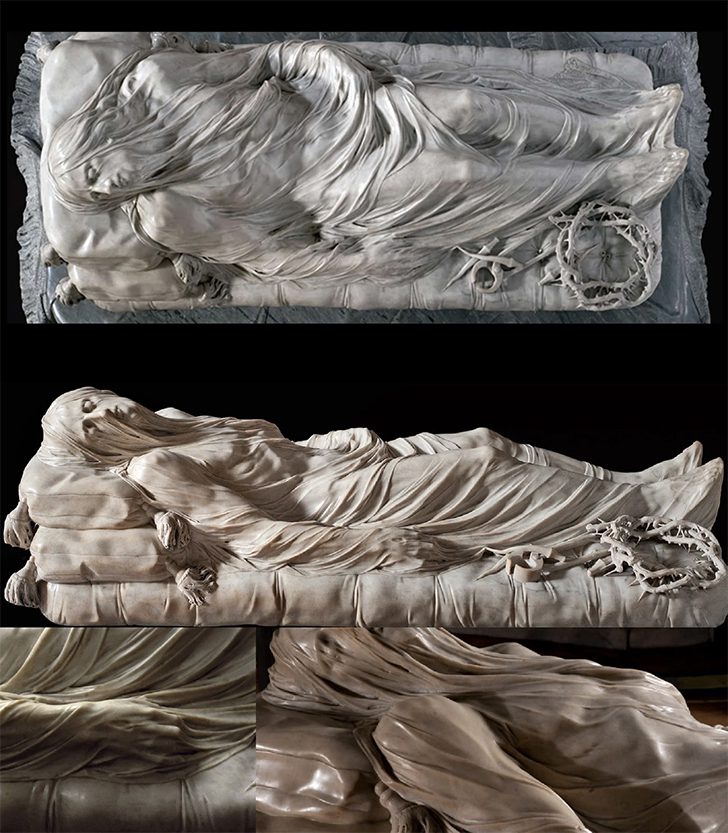
The Veiled Christ, a masterpiece created by Giuseppe Sanmartino in 1753, remains a marvel of artistry and illusion. Commissioned by Raimondo di Sangro, Prince of Sansevero, the sculpture astounds viewers with its lifelike veil, a testament to Giuseppe's technical virtuosity.
The method behind this illusionary masterpiece remains a subject of discussion and debate. Some suggest that Giuseppe employed "statuary scrimshaw," a technique involving intricate carving through multiple layers of marble to create the veil's transparent appearance. This awe-inspiring sculpture blurs the boundary between art and reality so convincingly that some believe it to be a depiction of a real miracle.
Kurt Russell and Mary Kay Place in the Film "Captain Ron," 1992
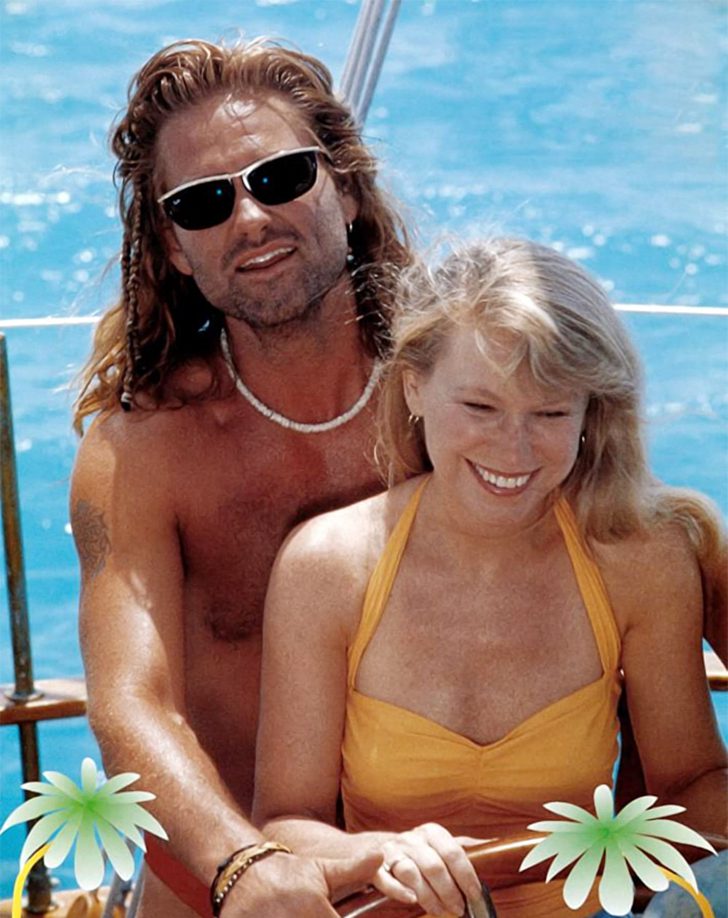
In the 1992 comedy film "Captain Ron," a captivating photograph captures Kurt Russell and Mary Kay Place lost in character. Initially, Kurt was set to play Martin Harvey, a role ultimately filled by Martin Short. After a booze-fueled evening, Kurt and Martin decided to switch roles, sending the film's crew scrambling to adjust the script and costumes.
Despite the role reversal, the film tanked both critically and commercially, grossing just $26 million against its $30 million budget. Nevertheless, "Captain Ron" has since navigated its way into cult status, buoyed by Kurt's memorable performance and the film's quirky and heartwarming narrative.
Female American Bomber Pilot Shirley Slade for Life Magazine, 1943
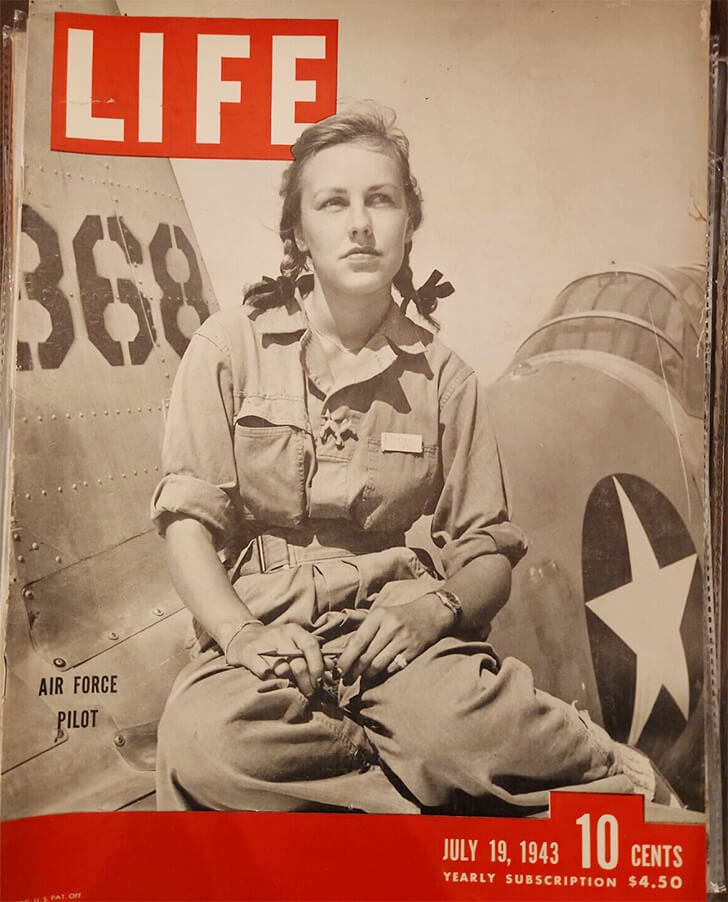
Shirley Slade soared through glass ceilings, literally. One of the elite 1,100 women selected for the Women Airforce Service Pilots (WASP), she navigated the skies during a time when most women were grounded by societal norms. Unlike many of her contemporaries, Shirley wasn't confined to light aircraft; she was trained to commandeer the formidable B-26 and B-39 bombers.
This was no small feat—these planes were complex machines, often dubbed "widow makers" for their challenging operation. Shirley's role was more than just a job; it was a statement of defiance against gender boundaries and a critical contribution to the war effort.
A Rare View of the Statue of Liberty, 1930s
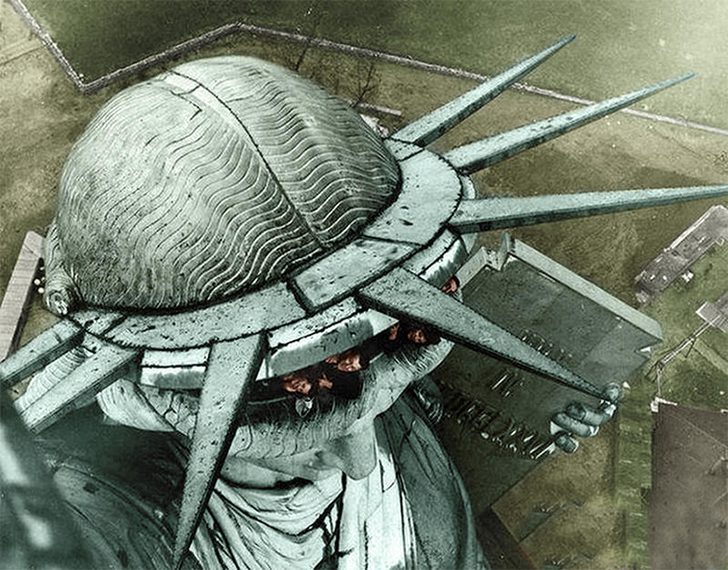
This photo offers a rare glimpse from the Statue of Liberty's torch balcony, taken in July 1916, before it was damaged by the Black Tom Island explosion. Orchestrated by German agents, this act of sabotage not only killed at least four people and injured dozens but also inflicted damage on the iconic statue itself—a piece of shrapnel embedded in its torch.
As a result, the torch balcony was closed to the public for years and remains off-limits today due to safety reasons. The Black Tom explosion had far-reaching impacts, swaying public opinion in the U.S. against Germany during World War I and prompting heightened security measures at key infrastructures.
Workers at the Civil Courts building in St. Louis, 1928
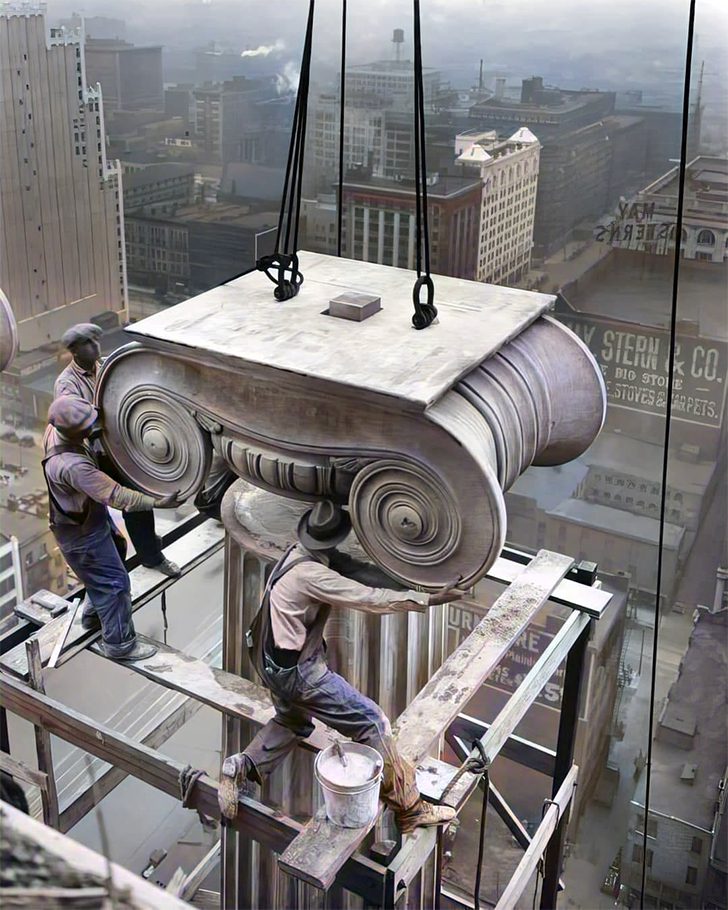
Think about the year 1928, and you're on the bustling streets of St. Louis, Missouri. Your eyes catch a group of workers high above, meticulously affixing a grand Greek Revival column to the still-unfinished Civil Courts building. Captured by photographer W.C. Runder, this invaluable snapshot is the only known record of the building's construction process.
Fast-forward to today, and the edifice, now the seat of Missouri's 22nd Judicial Circuit, remains a monument to both history and artistry. Modeled after the Mausoleum at Halicarnassus, its Indiana limestone columns are crowned with elegant Corinthian capitals, and its façade is adorned with mythical griffins.
"The Tin Man" From the Film "The Wizard of Oz," 1939
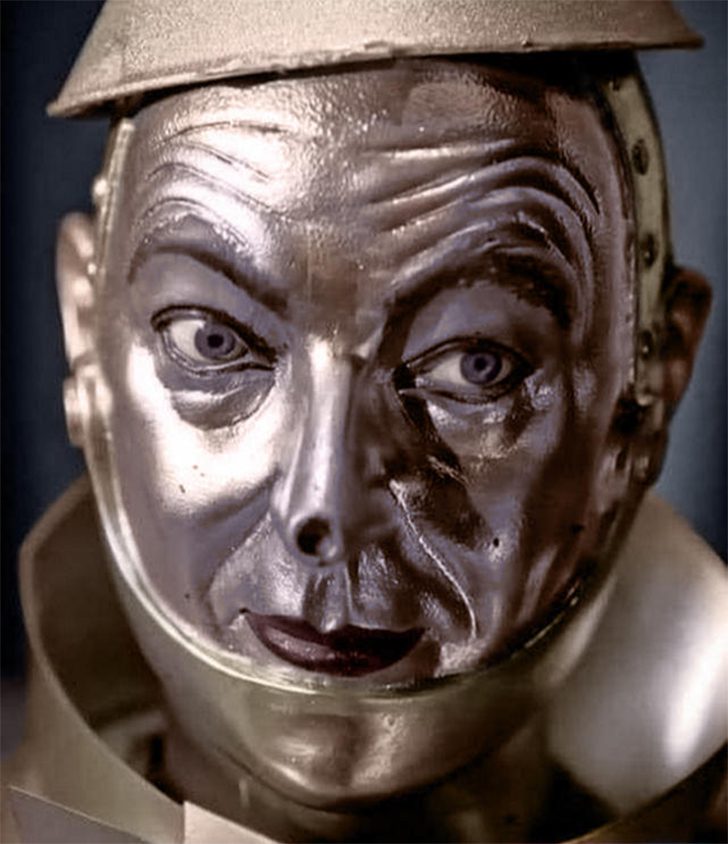
The chilling photograph of Jack Haley as "The Tin Man" in "The Wizard of Oz" evokes a sinister air that contrasts sharply with the film's fairy-tale magic. But what's even more haunting is the story behind the makeup—literally skin-deep in danger. Jack was a last-minute replacement for Buddy Ebsen, who was hospitalized due to a severe allergic reaction to the aluminum-based makeup. Jack faced the same fate.
Margaret Hamilton, the Wicked Witch of the West, also suffered burns from the hazardous makeup. This eerie image serves as a potent reminder of the early film industry's perilous corners and the lengths we've come to prioritize actors' safety today.
Elvis Presley on His 1971 Harley-Davidson FLH Electra-Glide in Memphis, 1972
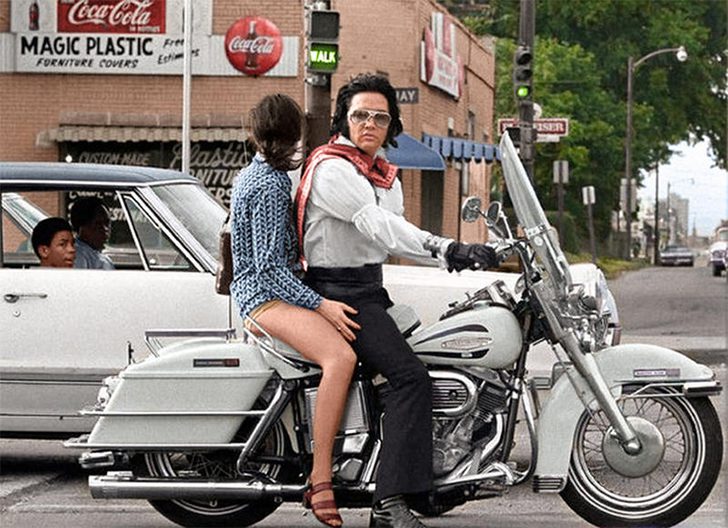
Elvis Presley and Mary Selph were seen cruising through Memphis on Elvis' motorcycle. But here's the back story: Mary was a singer and dancer at the Whirlaway Club, where she caught the eye of Elvis' entourage, "The Memphis Mafia," due to her resemblance to his ex-wife, Priscilla.
Taking an immediate liking, Elvis and Mary dated briefly. Tragically, just a month after this photo was taken, Mary died in a fatal traffic accident. For years, the identity of the young woman in the photo remained a mystery. It was only in January 2000 that her mother, Peggy, confirmed it was her daughter, unlocking the story behind this photograph.
The Foot of a Marble Marcus Aurelius Statue Unearthed in the 2000s
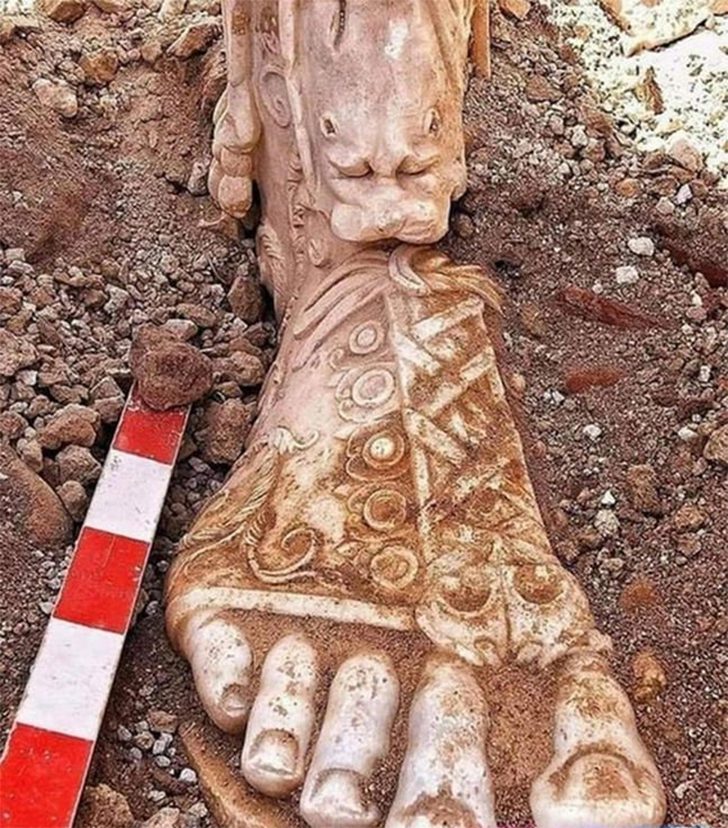
Emerging from the ruins of ancient Sagalassos in Southern Turkey, the marble foot of a statue depicting Emperor Marcus Aurelius offers an eerie yet captivating glimpse into Roman grandeur. The statue was discovered in Roman baths, shattered by a 6th-century earthquake but preserved beneath layers of rubble for more than a millennium.
The white marble sculpture captures the emperor in a toga, scroll in hand, his face a study in stoic calm as he gazes skyward. Now exhibited at the Sagalassos Museum in Turkey, this exceptional artifact not only speaks to the prowess of ancient Roman sculptors but also stands as a silent, enduring testament to the empire's once-mighty reach.
An A-list Ensemble at the "Interview With the Vampire" Premiere, 1994
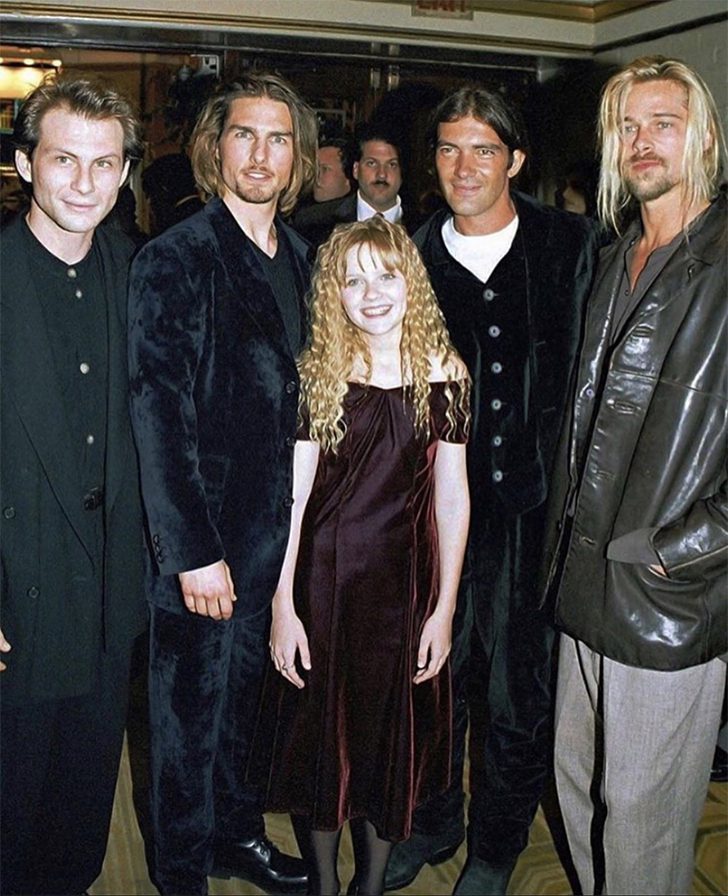
The 1994 premiere of "Interview with the Vampire" was a glamorous affair that could only be rivaled by the film's on-screen allure. Stars Brad Pitt, Tom Cruise, Kirsten Dunst, Christian Slater, and Antonio Banderas gathered to celebrate a movie that would go on to gross over $223 million worldwide.
The physical sacrifices were as compelling as the story: Tom Cruise and Brad Pitt endured hanging upside down for 30 minutes to achieve the vampires' veiny appearance. Filming primarily at night in London's winter chill, the cast and crew battled the elements but emerged victorious, capturing an Academy Award for Best Makeup.
Steve McQueen and Ali MacGraw Hanging Out in Jamaica, 1972
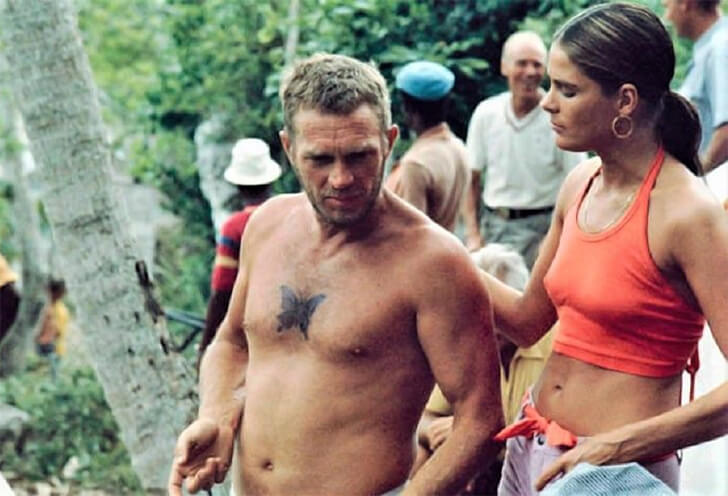
In a sun-drenched snapshot from the 1970s, Steve McQueen, the "King of Cool," and Ali MacGraw, his second wife and fellow Hollywood star, are the epitome of effortless glamour as they bask in the Jamaican sun. Married from 1973 to 1978, their union was a meeting of two cinematic titans, both radiating the rebellious spirit that defined the era.
This photo likely captures a leisurely pause from Steve's demanding filming schedule for the 1973 classic "Papillon," where he starred alongside Dustin Hoffman. Just like their scintillating on-screen performances, this candid moment offers a tantalizing glimpse into the lives of two Hollywood icons at the zenith of their careers.
Jack Nicholson, Dennis Hopper and Wife Michelle Phillips at the 42nd Academy Awards, 1970
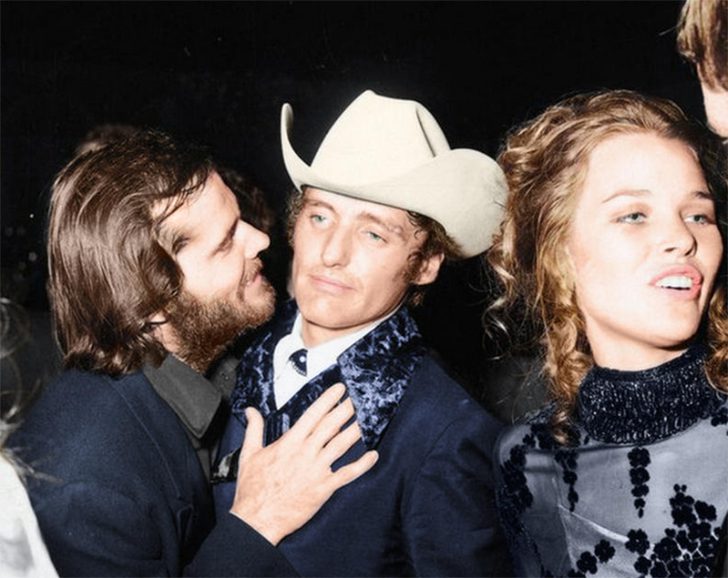
Imagine the electric atmosphere at the 42nd Academy Awards, charged further when Jack Nicholson, the quintessential Hollywood rebel, huddled with close friend Dennis Hopper and the enchanting Michelle Phillips. With a filmography as rich as Jack's, it's no wonder he and Dennis, a cinematic iconoclast, were kindred spirits.
But the plot thickens: Hopper was once married to Michelle for a fleeting eight days, and Michelle herself was a past love of Jack's, their relationship fizzling after two years. Amid tuxedos and gowns, these Hollywood mavericks gathered, their intertwining personal histories as gripping as any screenplay. It was a moment where life truly imitated art.
Linda Vaughn, the Legendary "Miss Hurst Golden Shifter," 1960s
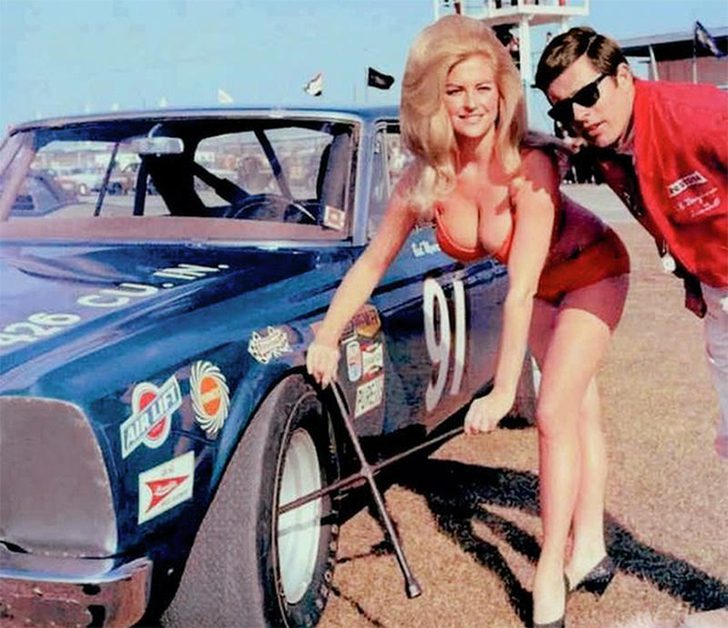
Linda Vaughn, widely celebrated as the "Miss Hurst Golden Shifter," is an enduring icon in the world of motor racing. Born in 1943 in Fort Wayne, Indiana, she broke onto the scene in the early 1960s as an ambassador for Hurst Performance Products. Her infectious enthusiasm and encyclopedic knowledge of the sport soon made her a beloved figure at racing events nationwide.
Beyond the racetrack, Linda is a successful entrepreneur with her own clothing line, a published author, and a frequent feature in various media. Pioneering the way for women in a predominantly male-dominated sport, she stands as a role model and an inspiration for women and racing fans alike.
Cesar Romero as "The Joker" on the Set of the TV Series "Batman," 1967
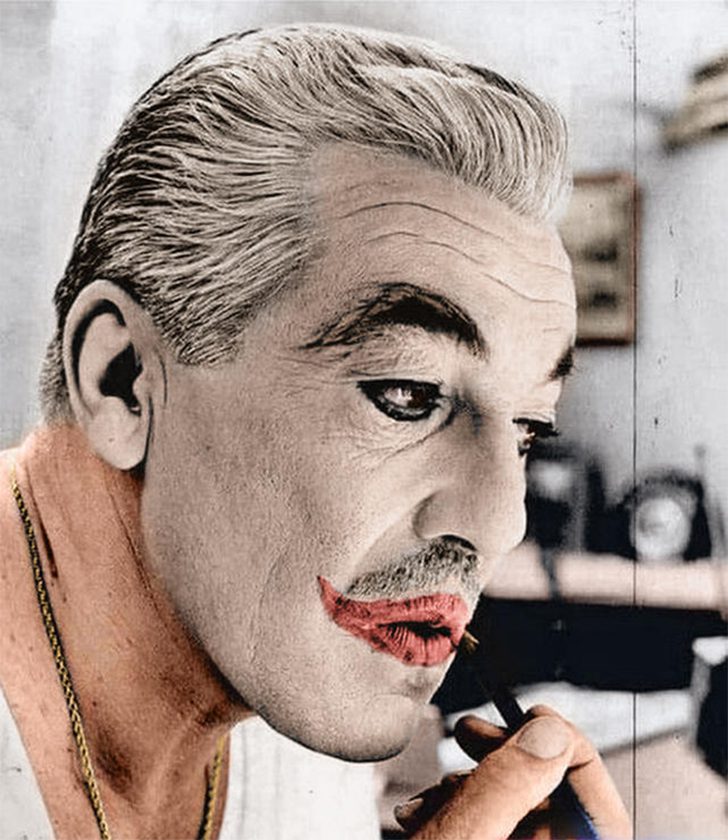
In an evocative behind-the-scenes photo, Cesar Romero sits absorbed in the art of transforming into the Joker for the 1966-1968 TV series "Batman." With a career spanning six decades, it was this whimsical, campy role that catapulted him to a unique brand of fame. Cesar was the trailblazer, the first to bring the Joker to life in a live-action format.
His explanation for the character's iconic green hair was simple yet impactful; it was true to the original comics. This commitment to authenticity set the standard for every actor who would step into the Joker's chaotic shoes thereafter, making the green hair an indelible part of this legendary villain's persona.
Jackie, John, and Ethel Kennedy Pioneering the Selfie, 1954
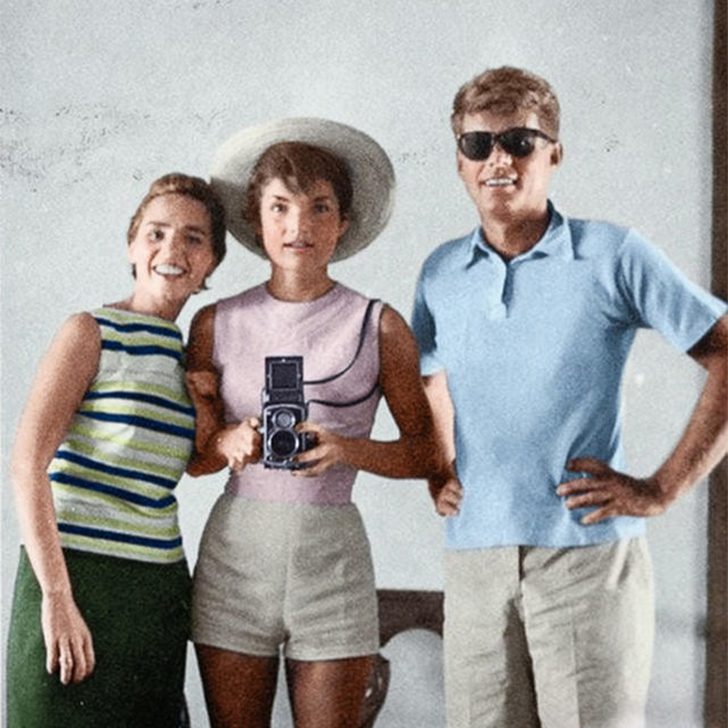
Before smartphones and the selfie craze, Jackie Kennedy was ahead of the curve. In a fascinating 1950s snapshot, she ingeniously captures her family's reflection in a mirror—presenting John F. Kennedy and sister-in-law Ethel Kennedy alongside herself. It's a proto-selfie that drips with the charm and elegance we've come to associate with the Kennedys.
Ethel, now a spirited grandmother, continues to be a force of nature, living in New York City. She's a philanthropist and social activist, founding the Ethel Kennedy Center for the Arts and Humanities. This retro "family selfie" is not just a throwback; it's a window into the lives of three extraordinarily impactful individuals.
The Ski Lift at Snow King in Jackson, Wyoming, 1960s
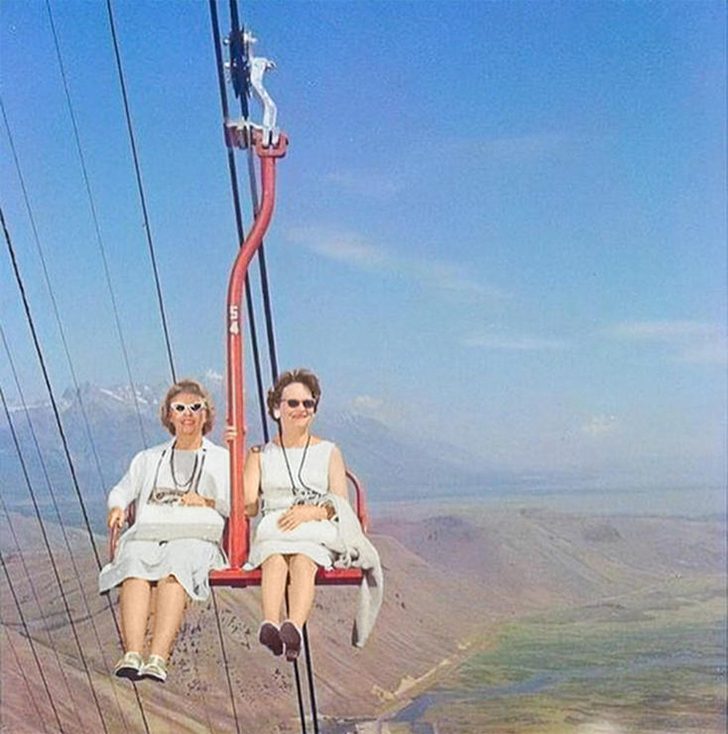
This crazy photo showcases a slice of skiing history: two ladies effortlessly gliding through the slopes of Snow King on a chairlift in Jackson, Wyoming—remarkably without any safety belts. Established in 1937, the Jackson Hole Ski Club was a pioneer in winter sports, erecting its first ski lift just two years later.
Initially designed for solo riders, the ski lift eventually evolved into a double-seater to accommodate the area's growing popularity among skiers and tourists. This image serves as a vivid reminder of how daring people used to be before safety became a higher priority; what was once a belt-free ride is now securely fastened.
Knife Grinders Lying Face Down at Work, 1900s
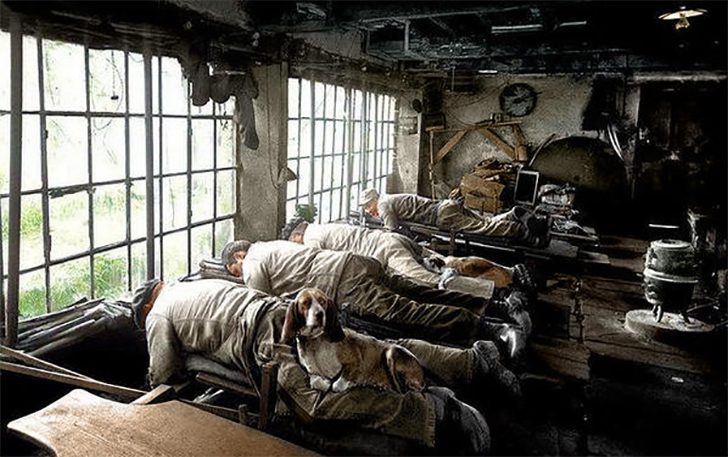
Step back in time to early 20th-century France, where knife grinders, lying face down to protect their backs, offer a fascinating snapshot of a bygone era. In an age before factory-made knives, these traveling artisans roamed from village to village, sharpening blades and spinning stories.
Shielded by leather aprons and often joined by their canine companions, these knife grinders—also known as "yellow bellies" due to the yellow dust that coated them—were as essential to community life as they were to kitchen functionality. Though the art of knife grinding has largely been replaced by modern methods, the compelling visual of these artisans at work continues to capture our imagination.
A Lineman Working on Telephone Lines, Kansas, 1911
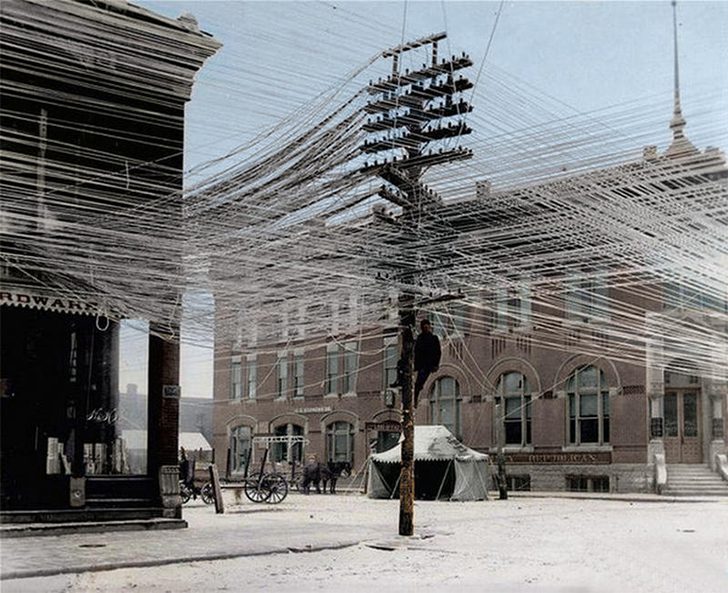
In an arresting 1911 photograph from Pratt, Kansas, a lineman is captured in a perilous situation, manipulating telephone wires. This was a time when the hazards of linework were extreme; uninsulated wires carried high-voltage electricity, resulting in frequent accidents that caused injuries and fatalities.
That same year, in a groundbreaking move, linemen took matters into their own hands by forming the International Brotherhood of Electrical Workers or IBEW. Their advocacy efforts for workplace safety have been instrumental in reducing the incidents of lineman injuries and deaths. Thanks to their work, along with non-stop technological advances, linework has become a much safer occupation.
An Eerie Photo of the Construction of the Statue of Liberty in France, 1882
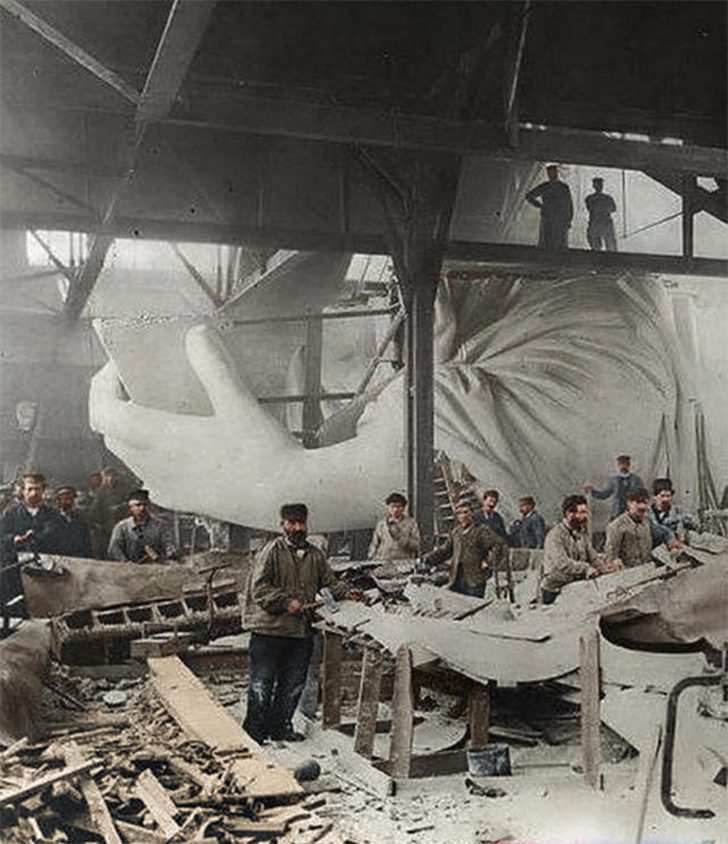
Capturing a moment that epitomizes human ingenuity and ambition, this rare photo showcases workers dwarfed by the enormous hand of the Statue of Liberty while still under construction in France. This iconic symbol took years to complete before making its transatlantic journey to grace New York Harbor.
Unveiled to a crowd of over a million in October 1886, the monument was a marvel of craftsmanship. Comprised of hand-hammered copper sheets welded together and supported by an iron and steel frame, the statue is towering 150 feet, including its pedestal. The torch that the statue holds was originally made of copper until it was changed in 1916.
A Couple Finds a Private Spot at the Beach in Santa Monica, 1950
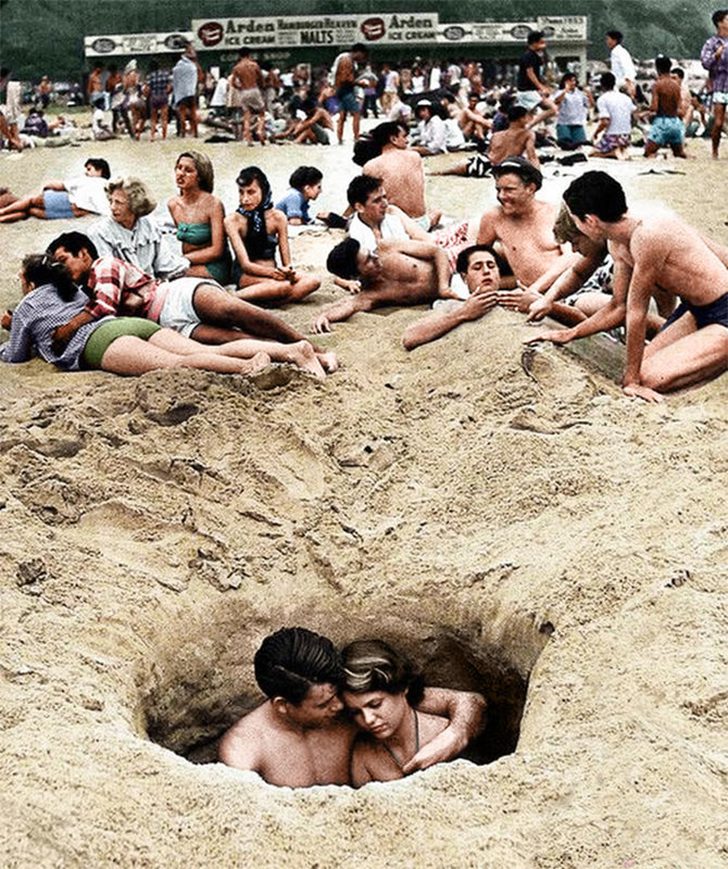
Captured by Ralph Crane and published in the Los Angeles Times in 1950, a remarkable photo from Santa Monica Beach epitomizes the essence of Independence Day celebrations. Amid a bustling crowd, a couple has carved out their own sanctuary, building a charming shoulder-deep hole to mark their private space.
In a whimsical twist, another man in the background is entirely submerged in sand, thanks to the collaborative efforts of friends—a playful act known as "sand duking," a competitive yet joyful way to escape the heat. This photograph eloquently showcases the spontaneous, carefree spirit that permeated the beach on that holiday.
The Elk Horn Saloon in Montana, 1915
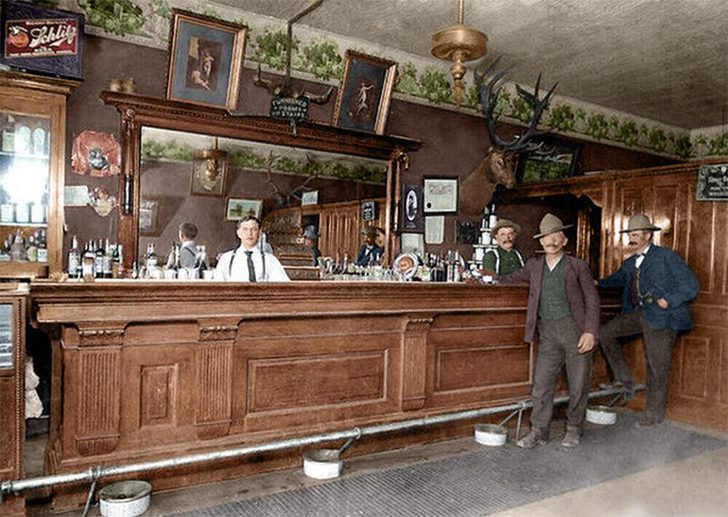
Step into the Elk Horn Saloon in Fergus County, Wyoming, circa 1915, and you'll find yourself in a different world. In this photograph, men don an array of jackets and derby hats, epitomizing the era's formal fashion norms. Among them stands Sheriff Ed Martin, one leg casually raised, embodying the rugged authority of the Old West.
Spittoons grace the floor, fashioned from metal or ceramic, for hygienic disposal of fluids. Dominating the room is an elk head mounted prominently on the wall. More than mere décor, it symbolizes the saloon's name and underscores themes of strength and power, captivating anyone who enters this timeless snapshot of American history.
Shoeshine Boys on Their Lunch Break in New York City, 1947
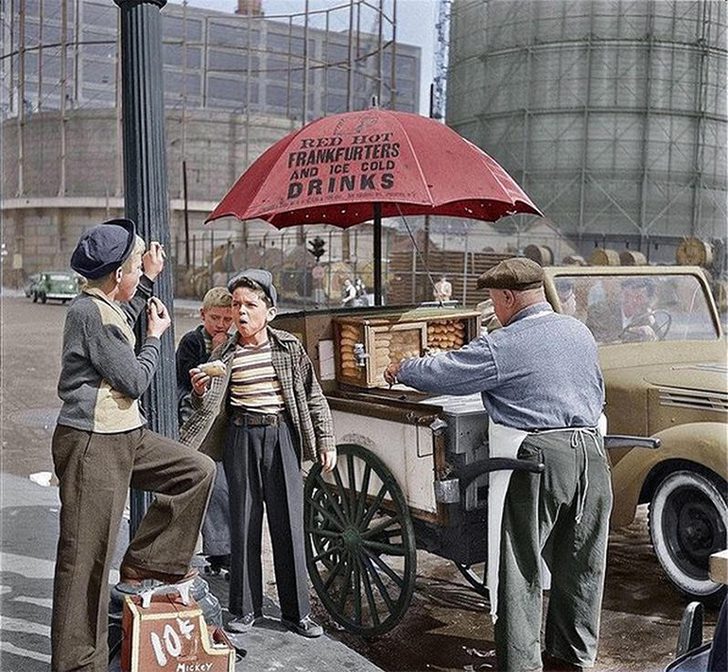
Two shoeshine boys nonchalantly talk beside this hot dog cart, enjoying a brief lunch break like a bunch of old-timers. Their relaxed postures might trick you into thinking they are grown men, yet they are only children. Their mature stances are a testament to the adult responsibilities they've had to shoulder at a young age.
Captured in this unvarnished moment is the gritty reality of life's challenges that some children had to face in the 1940s in New York. Shoeshine boys would often work from day to night and in difficult conditions along the sidewalk to help find income to support their families.
Watching a Chicago Cubs Baseball Game From a Tree, 1932
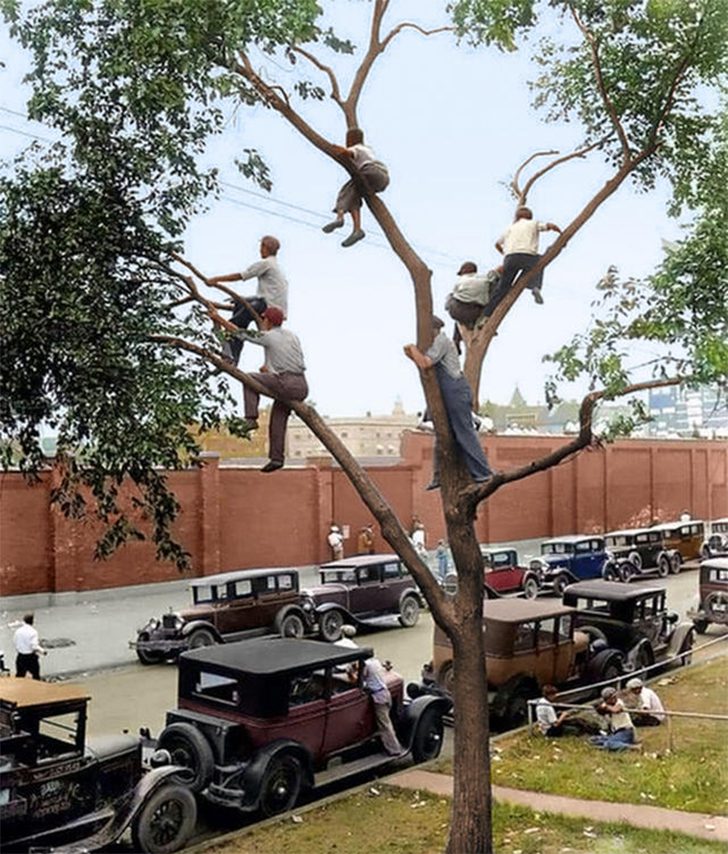
In 1932, the Chicago Cubs' stellar season culminated in a face-off against the New York Yankees in the World Series. With a regular-season record of 98 wins and 54 losses, the Cubs had already drawn over a million fans to Wrigley Field. Game 3 of the series alone saw a staggering 90,000 spectators flood the legendary ballpark.
Yet, not everyone had a seat inside—evidenced by this photo that captures a group of men perched in a tree outside the stadium. As cars jammed the streets in a testament to the game's popularity, these daring fans scaled nature's bleachers for an unconventional and possibly free view of baseball history unfolding.
Charlton Heston and Linda Harrison 1968
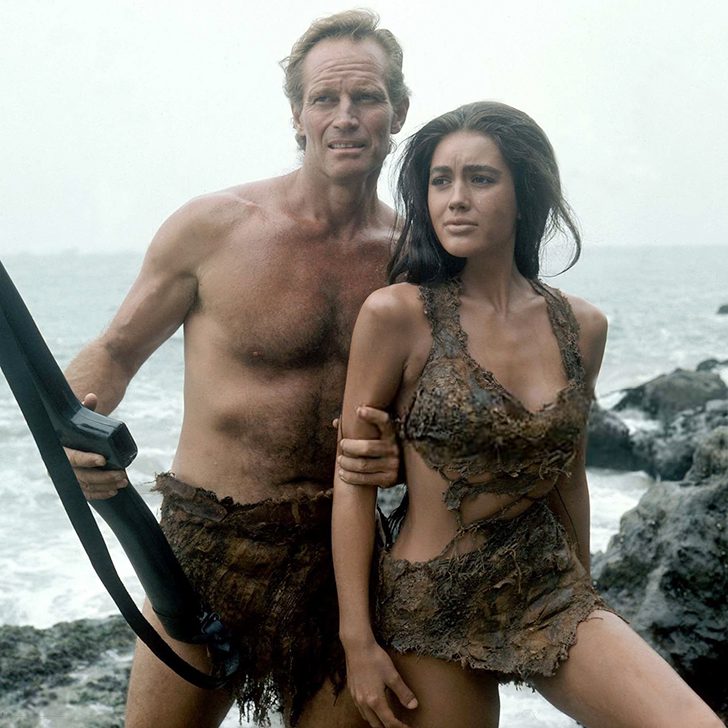
When the original film "Planet of the Apes" came out in 1968, it was a critical and commercial success, grossing over $32.6 million at the box office. The film starred Charlton Heston, who was a highly successful actor in Hollywood who had appeared in almost 100 films.
Charlton starred in the film with Linda Harrison, and he agreed to star in the picture on the condition that his character, George Taylor, was killed off in the first film. Charlton's decision to be killed off in the first film was a controversial one, but it ultimately paid off, as it helped to make "Planet of the Apes" a classic film.
A B-25 Bomber Plane Crashed Into the Empire State Building, 1945
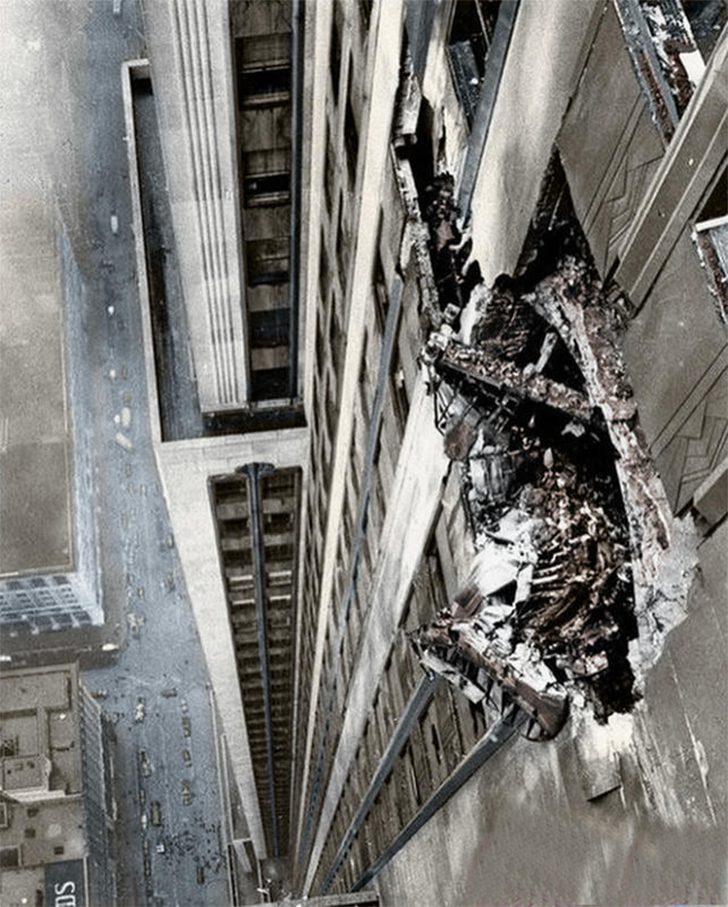
In a frightening twist of fate, on July 28, 1945, a B-25 bomber smashed into New York City's iconic Empire State Building. Lieutenant Colonel William Smith, Jr., piloting the plane, couldn't see the looming structure over a dense fog until it was too late. The crash caused 14 deaths and injured 26 people.
The ensuing fire raged for hours, but thanks to the building's fireproofing functions, it was contained to just a few floors. Remarkably, the rest of the building resumed operations in less than 48 hours. While the incident was a tragedy, it also demonstrated the resilience of the Empire State Building and New York City as a whole.
Pro Wrestler Ric Flair With a Young Dwayne Johnson, 1980s
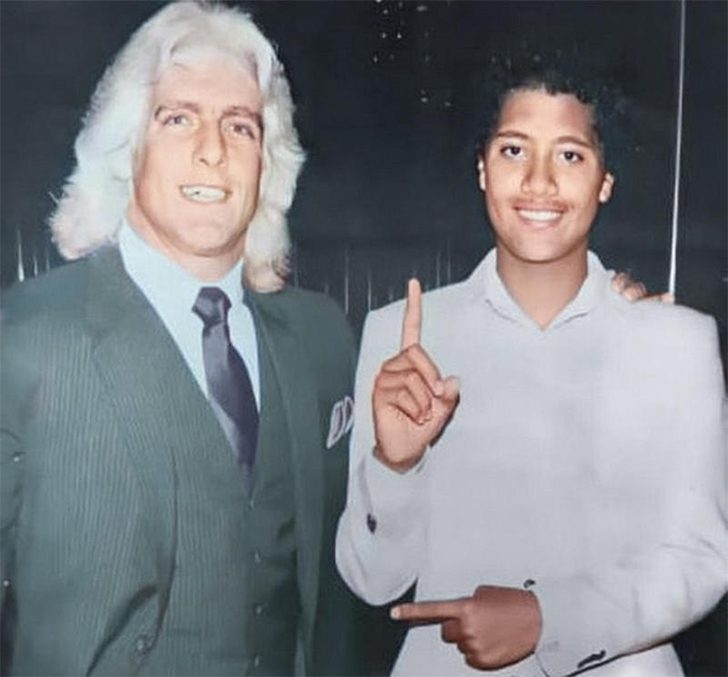
When you glimpse a photo of a young Dwayne "The Rock" Johnson standing beside Ric Flair in the 1980s, you're not just looking at two wrestling legends; you're witnessing a transformative moment in time. Dwayne was only 15 and already an ardent fan of Ric Flair, considered by many as the GOAT (Greatest Of All Time) in professional wrestling.
Moving forward, Ric has mentored Dwayne throughout his multifaceted career and developed their friendship. Highlighting this enduring respect, Ric tweeted the nostalgic photo in December 2021, stating, "I look up to him too." This heartwarming snapshot serves as an enduring testament to the power of never giving up.
The World’s Last Commercial Ocean-Going Sailing Ship, 1949
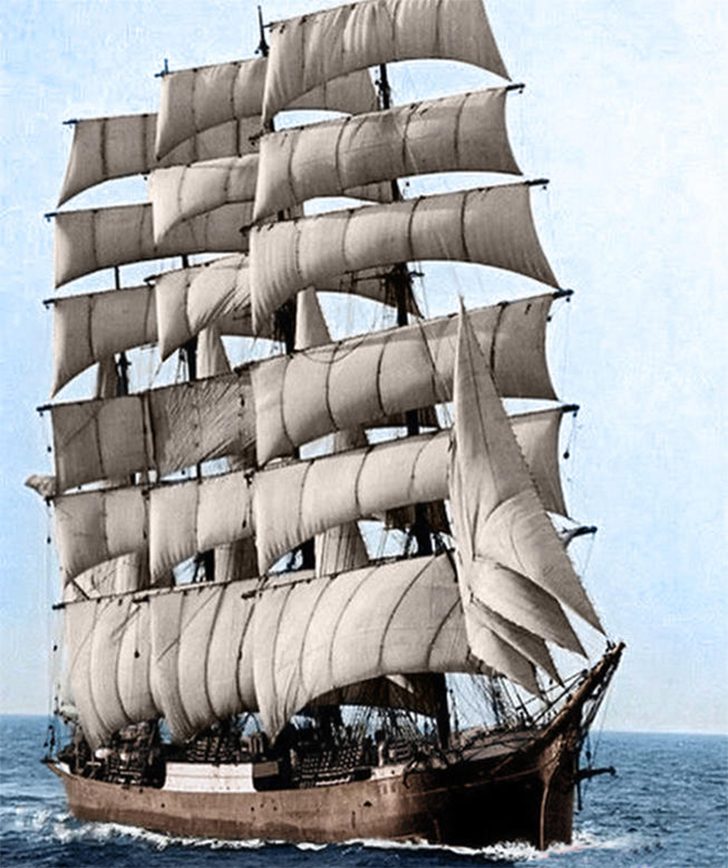
In maritime history, the Pamir stands as a haunting testament to the golden era of commercial sailing ships and the inherent risks of ocean voyages. Built in 1905 for a shipping company, the Pamir was a rare sight, one of the last to navigate the treacherous waters around Cape Horn.
On September 21st, Hurricane Carrie shattered the Pamir off the Azores, sinking her and claiming all but six of her crew. This tragedy marked not just the end of a ship but symbolized the close of an era in commercial sailing, forever reminding us of the ocean's unforgiving power.
Mick Jagger at the Original Playboy Mansion in Chicago, 1972

From the whirlwind of the rock 'n' roll world, this memorable snapshot shows Mick Jagger at the original Playboy Mansion in Chicago in 1972. At the apex of their creative powers, Mick and Keith Richards—The Rolling Stones' iconic songwriting duo—were known for their raucous parties.
That year, the Playboy Mansion nearly became ashes to their legend when Keith set a smorgasbord ablaze, causing considerable damage but miraculously no casualties. The incident didn't dim their star but added another layer to their mythos. Later relocated to Los Angeles, the Playboy Mansion has since become a cultural landmark, featured in numerous movies and TV shows.
Olympian Legend Wearing Mismatched Shoes, 1912
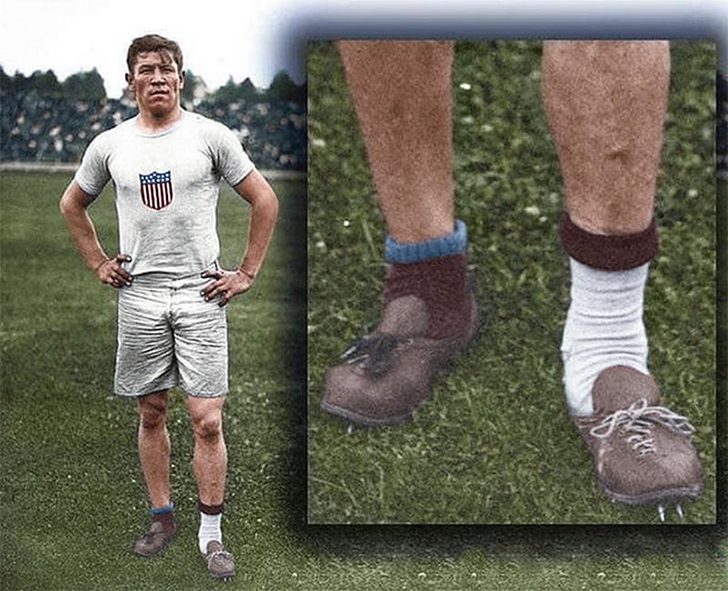
Captured in a riveting photo, Jim Thorpe stands clad in mismatched shoes at the 1912 Summer Olympics in Stockholm. In an extraordinary turn of events, Jim had to scour a trash can for these mismatched pairs just before his pentathlon and decathlon events. Undeterred, he wore extra socks to balance the irregular fit.
What happened next was the stuff of legend. Jim not only competed; he dominated, clinching gold medals in both events. He became the first American to secure multiple golds in one Olympics, catapulting him into national hero status and etching his name into the annals as one of the greatest athletes ever.
A Rare Photo of Gladys and Elvis Presley in a Portrait, 1940s
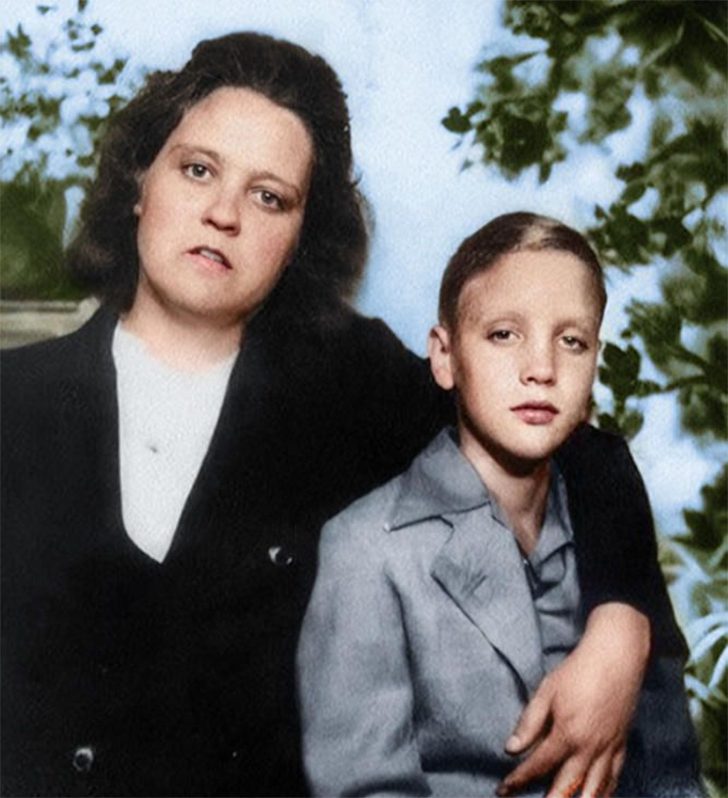
The rare 1940s portrait capturing a young Elvis Presley with his mother, Gladys, is a visual love letter that transcends time. Elvis called her "mama" throughout his life, and they shared an almost secret language, communicating in endearing baby talk.
While Vernon, Elvis' often-absent father, provided materially, Gladys was the emotional cornerstone. Priscilla Presley once remarked that Gladys was the "true love of Elvis' life," a statement that rings authentic considering their well-documented, profound bond. Yet, this wasn't mere motherly doting; it was a complex, multifaceted relationship that shaped the King of Rock 'n' Roll into the legend he became.
TV Personality/Actress/Model Jayne Kennedy, 1970s
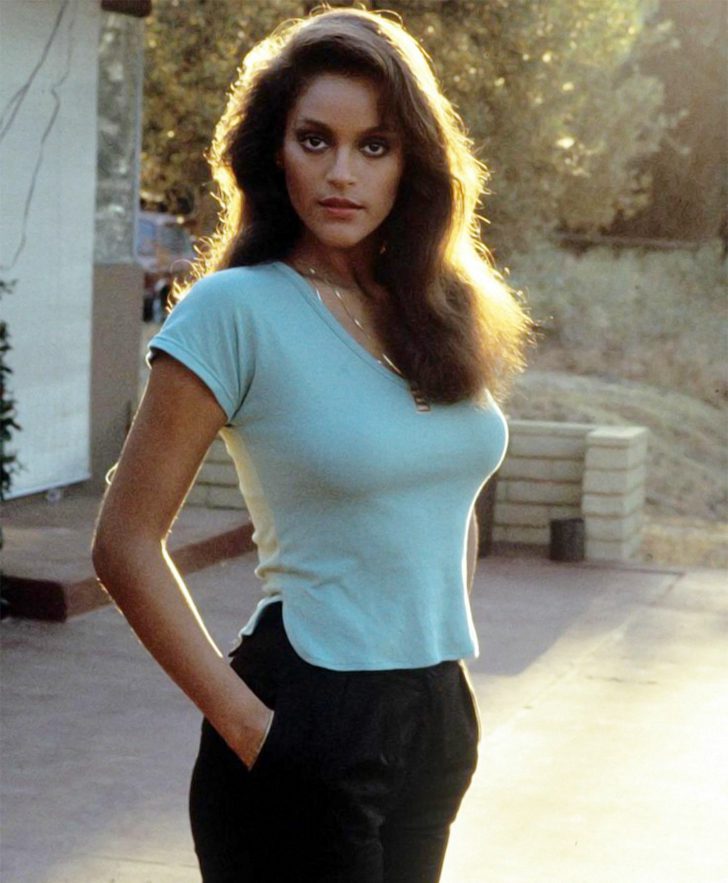
The captivating photo of Jayne Kennedy from the 1970s encapsulates the grace and poise of a groundbreaking figure. She started her illustrious career as a backup dancer on the iconic comedy show, "Rowan & Martin’s Laugh-In," further showcasing her versatility.
Over the years, her striking beauty graced numerous magazine covers, including the 1981 issue of Playboy. But Jayne's impact extends far beyond her physical allure. A stalwart advocate for gender equality, she's also an active philanthropist, contributing to various charities and foundations. Setting an exemplary standard, she's a role model to her four children, whom she shares with actor Bill Overton.
A Withheld Photograph of New York Tunnel Police, 1950s
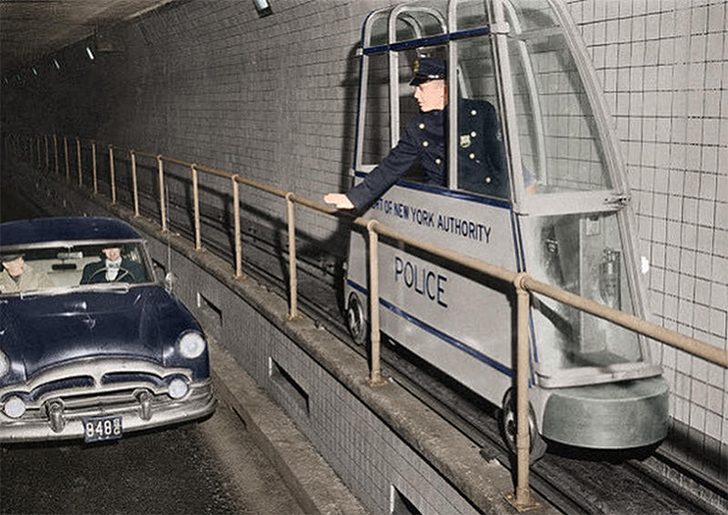
In the bustling metropolis of New York during the 1950s, an innovative solution emerged to aid the police force patrolling the Holland Tunnel. The "catwalk cars," introduced in 1954, became iconic symbols of safety beneath the Hudson River. These diminutive vehicles were tailor-made for the tunnel's narrow catwalks, which were previously patrolled on foot.
These one-seaters, with their eight-horsepower engines, could zip along at 35 mph and carried essential tools for officers, transforming the way patrols operated. Their resilience was proven by their service span, which extended up to 2011. The story of these cars exemplifies the city's continual evolution in the name of safety and progress.
"The Chief’s Daughter" Loti-Kee-Yah-Tede from Pueblo, New Mexico, 1905
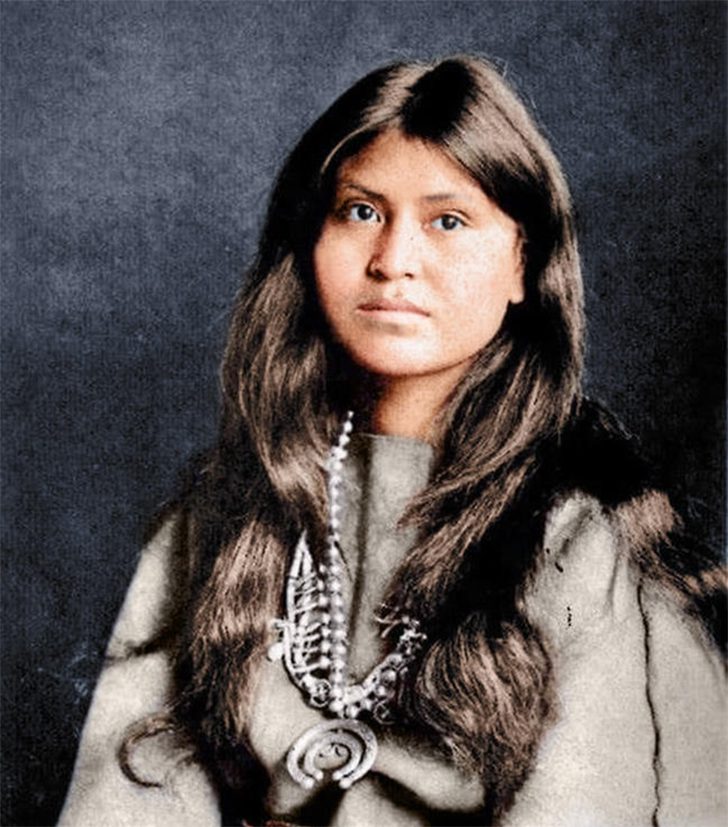
American photographer Carl Moon captured a timeless moment through his lens: a portrait of Loti-Kee-Yah-Tede, "The Chief’s Daughter" from the Laguna Pueblo tribe in New Mexico. This compelling image is among Carl's most celebrated works. Just two years after relocating to Albuquerque in 1903, Carl had already won acclaim for his sensitive and authentic depictions of local Pueblo people.
His reputation even earned him an invitation from President Theodore Roosevelt to exhibit his work at the White House in 1907. Carl, originally from Wilmington, Ohio, later moved to Pasadena in 1914, expanding his artistic repertoire to include children's book illustrations.
Howard Stern and His Crew Participating at Shea Stadium, 1985
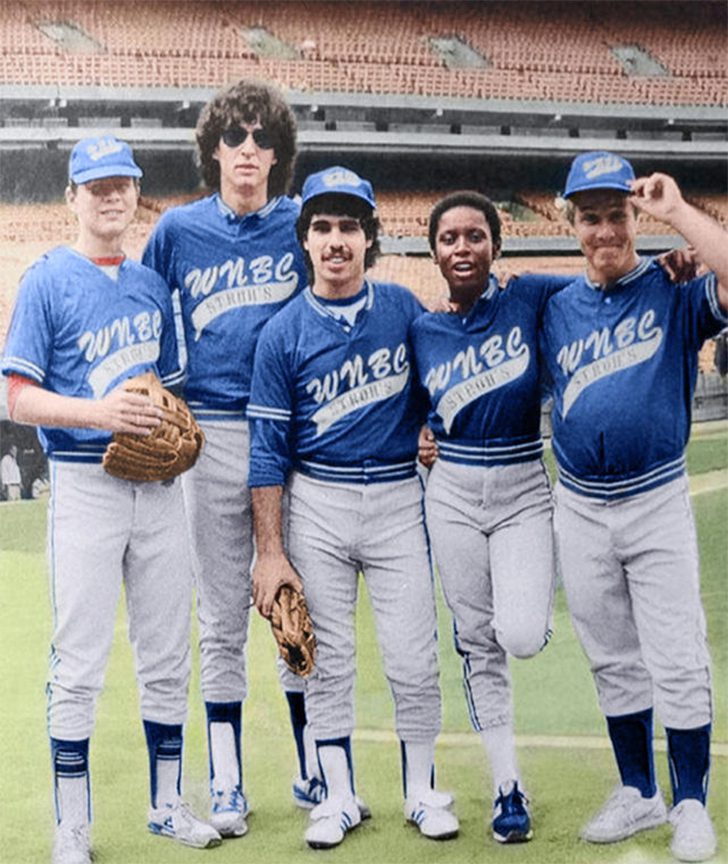
In 1985, the same year Howard Stern launched his now-iconic "The Howard Stern Show," he and his crew participated in a celebrity softball game at Shea Stadium. Fresh off the wave of launching his groundbreaking radio program, Howard took to the field with the same irreverent spirit that would make him a global radio sensation.
Although Howard grew up mimicking radio shows on a faux set his father built, he was now making waves in the real world, a success epitomized by this playful moment on the baseball diamond. Speeding to 2020, he renewed his SiriusXM contract, solidifying his status as the world's highest-paid radio personality.
Marlene Dietrich Detained in Paris for Improper Dressing, 1933
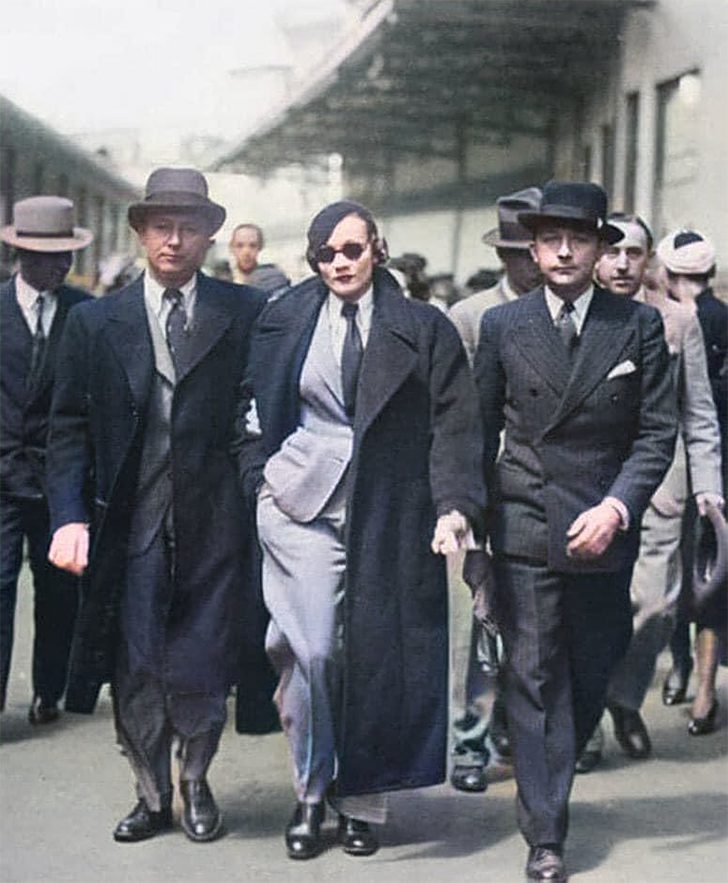
In 1933, the daring Marlene Dietrich turned heads—and raised eyebrows—when she was detained at a Parisian train station for defying the ban on women wearing trousers. Already a Hollywood icon and future Medal of Freedom recipient, Marlene was no stranger to pushing societal boundaries.
Her androgynous fashion choices, including suits and ties, made her a 1930s style icon and a pioneer in challenging gender norms. Her audacious act wasn't just a wardrobe choice; it was a rebellious statement that resonated through the decades. If she were alive today, Marlene would have celebrated her 120th birthday in December 2021, yet her legacy as a trailblazing trendsetter endures.
The C.D. Peacock Jewelry Store’s Doors, Chicago, Illinois, 1925
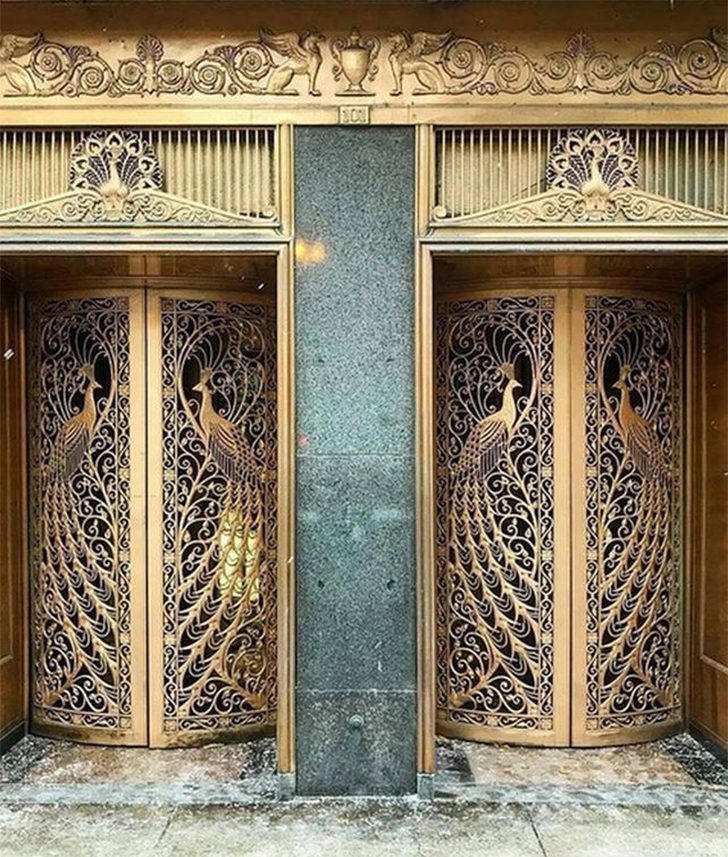
The striking Peacock Doors at the Palmer House in Chicago are an awe-inspiring fusion of art and architecture. These bronze masterpieces were originally crafted by Louis Comfort Tiffany in 1925 and initially designed for the C.D. Peacock Jewelry Store. With an intricate feather pattern echoing the store's namesake bird, the doors served as an opulent gateway until the store closed in 1993.
Now valued at over a million dollars, these doors have transcended their commercial origin to become a cherished tourist attraction. They are part of a trio known as the "Peacock Doors" and continue to dazzle visitors with their unparalleled craftsmanship.
A Rare Shot of Girls Passing Notes in Class, 1950s
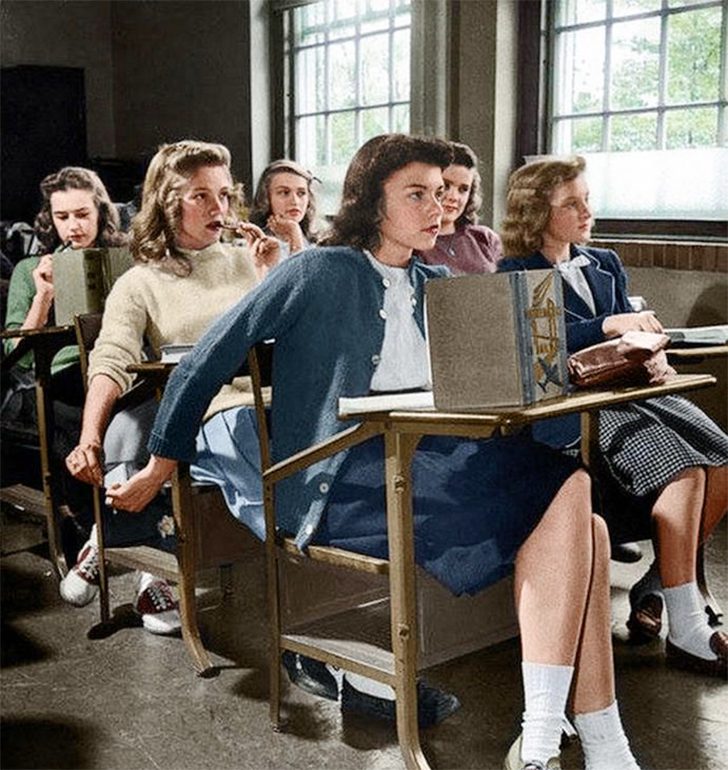
The 1950s classroom was a world apart from today's tech-savvy learning spaces. In an era devoid of cellphones and computers, students relied on discreetly passed notes to communicate or indulge in a little gossip. Captured in a rare photograph, girls engage in this time-honored ritual, their eyes darting cautiously to avoid the watchful gaze of authority figures.
In those days, teachers wielded considerable power and could mete out punishments ranging from detention to suspension for the seemingly innocuous act of passing a note. Though modern students enjoy greater freedom and technological means to communicate, the nostalgic charm of handwritten notes passed under desks endures a tactile memory of simpler times.
Titanic in Dry Dock 103 Years Apart, 1910s - 2015
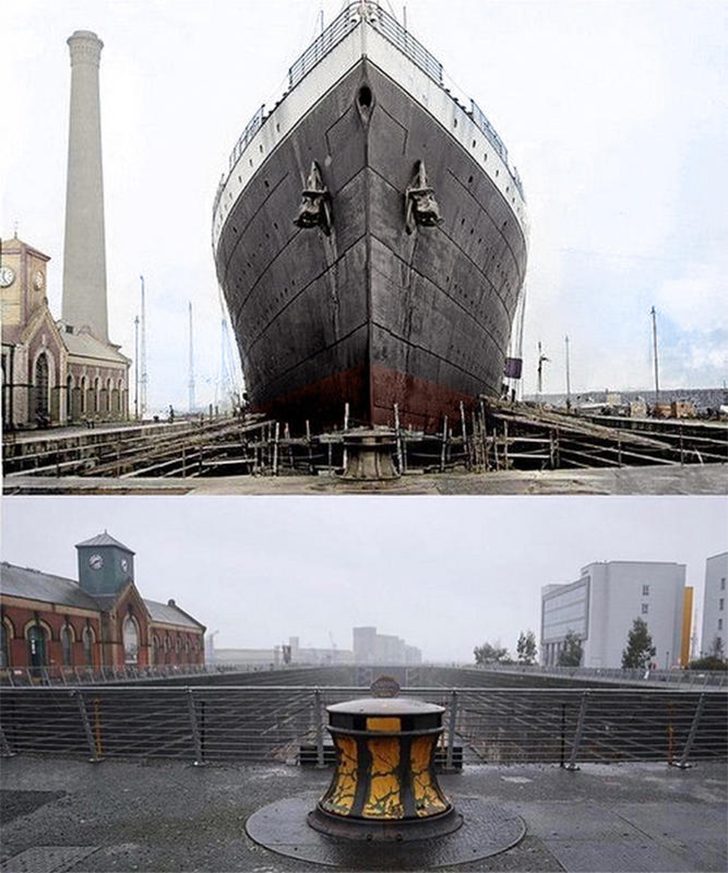
The side-by-side photo juxtaposes the Titanic in its dry dock in the 1910s with the same pier in 2015, serving as a haunting echo across time. While the ship was once deemed "unsinkable," it tragically sank in April 1912 after colliding with an iceberg.
Over 1,500 of the 2,200 passengers and crew lost their lives partly due to insufficient lifeboats. This catastrophe prompted worldwide changes in maritime safety regulations and has since permeated global culture through books, films, and art. Today, the ship's wreckage lies 12,415 feet below sea level; despite various attempts, it remains unrecovered—a somber monument to human folly and vulnerability.
Aerial View of Las Vegas, 1947
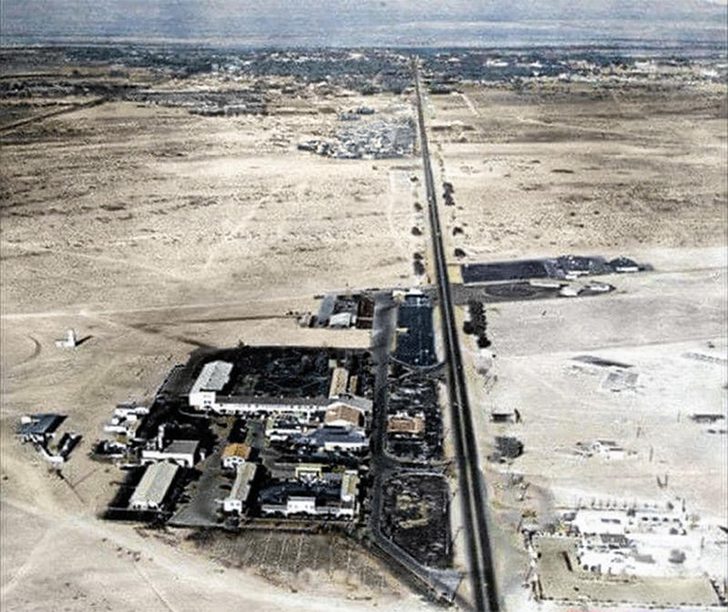 Look back and see this rare aerial view of 1947 Las Vegas, a city not yet crowned with the opulent skyscrapers and bustling casinos we know today. Instead, the heartbeat of the young desert oasis was Fremont Street, affectionately dubbed "Glitter Gulch" for its glitzy allure.
Look back and see this rare aerial view of 1947 Las Vegas, a city not yet crowned with the opulent skyscrapers and bustling casinos we know today. Instead, the heartbeat of the young desert oasis was Fremont Street, affectionately dubbed "Glitter Gulch" for its glitzy allure.
With not one high-rise in sight, this photo paints a compelling portrait of a town on the cusp of an explosive transformation into the world's entertainment capital. It's a nostalgic snapshot that showcases the city's modest roots while also underscoring the ever-present allure that continues to draw millions into its whirlpool of excitement and adventure.
The Stairs at Montmartre, 1932
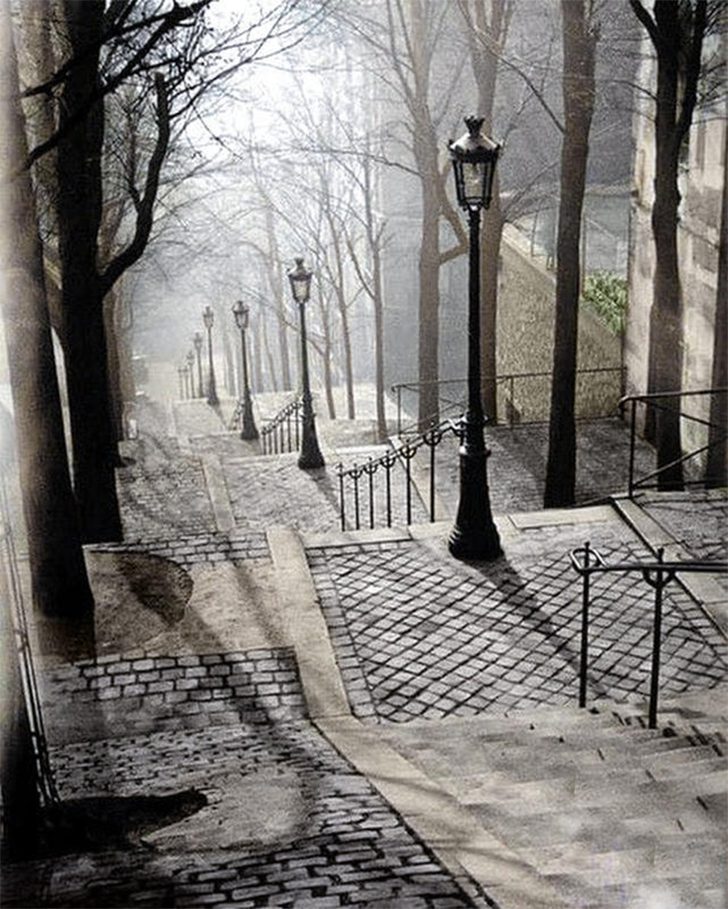
"The Stairs of Montmartre," an evocative photograph by Jules Halász, known as Brassaï, captures the nocturnal allure of Paris. Taken in 1936 atop Rue Foyatier's stairs in the historic Montmartre District, the image is steeped in atmosphere. The street itself opened in 1867, pays homage to sculptor Denis Foyatier, lending an artistic lineage to the setting.
Jules was renowned for his mastery of night photography, often wandering Parisian streets after dark to document everyday moments through his lens. His work stands out for its crisp details and mood-setting aesthetic. This iconic image is currently gracing the walls of the San Francisco Museum of Modern Art (SFMOMA).
The Chain Used for the Titanic’s Anchor, Circa 1910
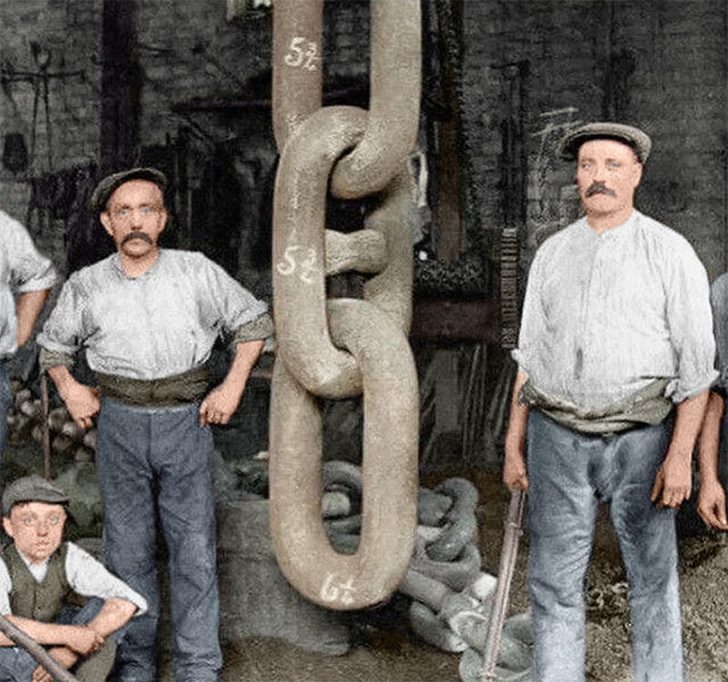
A marvel of engineering, the Titanic's colossal anchor was hand-crafted by Hingley and Sons, a firm rooted in Netherton and renowned for their Netherton Crown Special Best Best Iron. Founded in 1820 by Noah Hingley, the company had a long-standing reputation for excellence in shipping materials.
Commissioned in 1910, this awe-inspiring anchor stretched an enormous 18 feet six inches in length. The entire structure weighed an astounding 15 tons. While Hingley and Sons produced many notable items in their history, the Titanic's anchor remains their most infamous, a haunting reminder of the ship that sank in 1912, claiming over 1,500 lives.
